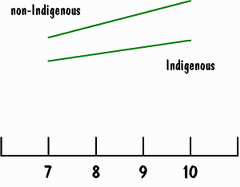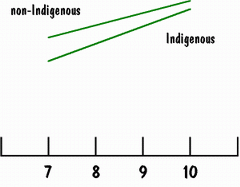INISSS:
Improving Numeracy for Indigenous Secondary School Students
INISSS (Improving Numeracy for Indigenous Secondary School Students) is a project of the Aboriginal Education Unit, Tasmania, Australia. In 1998 the Unit decided to take steps to try to close the achievement gap between Indigenous and non-Indigenous students.
INISSS Structure
Twenty secondary schools with a significant Aboriginal population were invited to commit at least two teachers and the school's Aboriginal Education Workers to an on-going series of two day residential seminar/workshops. The first was in August 1998, the next was in October. Through the following years the sessions continued at the rate of about 3 residences per year. Sessions were a balance between exploring Aboriginal issues, exploring alternative teaching strategies in mathematics and retelling and analysing changes that developed in schools.
Curriculum Corporation was asked to lead the mathematics component. The organisation's consultants had previously supported the development of hands-on problem solving tasks in conjunction with Aboriginal students and their teachers in schools across Northern Territory (1993) and, later (1996), with Aboriginal students and their teachers in the urban environments of Brisbane, Queensland.
For each residential seminar/workshop, INISSS schools received support for replacement teachers to allow staff to attend. Teachers returned to school:
- challenged to apply alternative teaching strategies,
- resourced with materials designed to support their risk-taking and
- committed to reporting their efforts to the next residential seminar.
Over time, the materials INISSS supplied included sets of tasks from the earlier work with Aboriginal students, additional tasks packaged in specific units and membership of Maths300. However, teachers quickly learned that INISSS was about changing teaching practices, not about collecting storerooms of equipment.
The evaluation tools for the project were multi-level:
- Anecdotal reflections of teachers were highly valued.
Teachers retelling their stories of struggle, failure and success was a powerful tool for both evaluation and collegiate support.
- Teachers volunteered to have their lessons video-taped by an independent, professional film maker and replayed at residences for critical analysis. INISSS has produced hundreds of hours of video which in many cases captures the same teacher in different classroom circumstances, or the same students at different times of the year.
- Research was undertaken to monitor student changes.
Throughout INISSS this extensive data collection and analysis was organised by Rosemary Callingham (formerly University of Tasmania, currently University of New England) and Patrick Griffin (University of Melbourne). The first problem faced by the researchers was that if students were going to be taught in a practical hands-on way, then testing instruments had to be devised that were consistent with the teaching techniques. Teachers had extensive input into the design of the testing instruments. This was ground breaking work in educational research and sophisticated statistical techniques were rigorously applied to ensure the validity and reliability of the results.
Mathematics Education Component
The prominent guiding principle was that all students can learn to work like a mathematician. Working Mathematically was detailed and illustrated over and over through the investigation of tasks and Maths300 lessons. Building on this input teachers began constructing their own Working Mathematically investigations and units of work. Some of these units are available on the Maths300 site.
A range of teaching practices including, but not limited to, hands-on learning, kinaesthetic learning, mathematical conversation, mixed ability teaching and group work were experienced in the workshops then applied in the classrooms. Educational research suggesting that students need time to construct their own learning, and Gardner's research into multiple intelligences, provided a scaffold for the sessions.
Teachers began their curriculum shift by regularly using tasks as an invitation to work like a mathematician. Whole class investigations developed from these as teachers and students worked together to explore how a mathematician might tackle a particular problem. Skill based lessons came to be called 'toolbox lessons' and were seen by teachers and students alike as part of the process of learning to work mathematically, rather than in their more traditional representation as the sum total of mathematics education.
Eventually teachers began to construct Working Mathematically units and later develop a vision of a Working Mathematically curriculum.
Research Results
There are mountains of data collected across a cohort of around 2000 students who were followed from Grade 7 to Grade 10 as their teachers continued their own efforts to learn more and more about mathematics teaching. Detail can be obtained from the Research Summary, but the trends in the data are clear, significant and, to the best of our knowledge, unparalleled.
The graphs below illustrate the trends in the data. They are not graphs of actual data - you will find those in the Research Summary - but they do show the statistically significant trends. The graphs were examined by Rosemary Callingham before publication. Comments with the graphs are taken from an email on July 19th 2002 giving approval to use them in this form.
Pre-1998
Mathematics
Tasmania
Years 7 to 10
...the picture ... is a generally accepted one. Certainly in 1997 only about 50% of Indigenous kids were achieving Year 8 outcomes (and this was in Year 9) compared with about 80%+ of non-Indigenous kids.
|

|
1998 - 2001
Mathematics
INISSS
Years 7 to 10
The overall picture of INISSS results is okay if a little exaggerated. But it does convey a picture of the improvement.
|

|
1998 - 2001
Mathematics
INISSS Girls
Years 7 to 10
The girls graph is good. By the end of the 4th assessment in Year 10 the Indigenous girls were doing better than the non-Indigenous boys and as well as non-Indigenous girls.
|

|
Rosemary added:
You might like to mention that we have replicated the results with INISSS B - a completely separate group (of teachers) - which gives me confidence in the overall picture.
Further analysis of the data looked at the students' results in literacy at Year 10. In an email on August 6th 2002, Rosemary writes:
- INISSS A Grade 10s (the kids we've tracked all the way through) did an English and Maths test that could be linked to statewide testing that they did as Grade 7s in 1998. We also gave the same tests to a control group of Year 10s.
- Kids in INISSS A showed greater improvement than the control group in both Maths and English but the change was particularly marked in English!!
- I suspect that it is because the task type approach emphasises explaining and justifying. The assessment we used demanded this too and teachers responded by deliberately getting kids to do this. The boys' literacy particularly improved (I suspect the maths context has a lot to do with this) and the girls' numeracy - a win/win situation!!
The following comments are notes taken at Rosemary's presentation to INISSS teachers in August 2002. They have also been approved as accurate for publication and further detail is available in the Research Summary.
Why The Success For Students?
- Investment in teachers and classrooms both in terms of providing and valuing substantial time for professional growth and providing physical materials to support curriculum shift.
- Non-trivial and purposeful mathematics. Maths presented in a context that makes intellectual (NB: not necessarily real-world) sense to the students.
- Appropriately resourced over a significant time frame.
- Rigorous evaluation - teachers believed sufficiently in what they were doing to risk setting themselves up for failure.
- Video taping and sharing practice.
- Focus on Indigenous issues that has raised awareness. Acknowledges the culture and teaches in ways that are more likely to include groups normally discriminated against.
- Contribution of non-teaching professionals, eg: Aboriginal Education Workers and community elders.
- Teacher input into the professional development, eg: content of assessment, content of some sessions (We need...), presentations from 'my classroom'.
INISSS Teachers at the presentation added these reasons:
- Participation!!! Sessions are deeply engaging workshops facilitated by a leader, rather than dominated and directed by a talking head. The professional development sessions consistently modelled the curriculum shift expectations.
- Iceberg of tasks. One of the resources supplied to the teachers was the Task Centre Kit for Aboriginal Students. Teachers learned that the problem solving task card is only the tip of a problem solving iceberg. The many worthwhile investigations that flowed from each card meant there were no ceilings on achievement. No presumptions about cognitive understanding and ability required to enter the task.
- Literacy in the maths for boys and numeracy in language for girls.
- The teacher's act of the using the problem solving tasks shifts the student perception of the teacher and affects the way the students respond to the learning.

Follow this link to Task Centre Home Base Welcome Page & Index.



